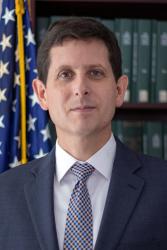The panel summarized here was part of the Spring 2022 Brookings Papers on Economic Activity (BPEA) conference. Greg Mankiw (Harvard University) and Phillip Swagel (Congressional Budget Office) contributed short papers to the Spring 2022 BPEA issue based on their remarks made at the conference. The recording of the panel can be found below. Read all papers published in this issue here. Submit a proposal to present at a future BPEA conference here.
In a panel discussion at the Brookings Papers on Economic Activity (BPEA) conference on March 25, three well-known economists—Greg Mankiw, Carmen M. Reinhart, and Phillip Swagel—explored the implications of interest rates and inflation for U.S. fiscal policy following the COVID-19 pandemic.
Mankiw of Harvard University, former chair of the White House Council of Economic Advisers, said negative real (inflation-adjusted) interest rates have so far made it possible for the government to afford what in the past would have been considered profligate borrowing.
“Delays in tackling inflation in the U.S. during the 1970s ended up requiring draconian measures that ushered in one of the deepest post-war recessions.”
Because most of the decline in real rates since the early 1990s can be explained by long-term economic trends that are likely to persist—including a higher world savings rate and a lower world growth rate—the government probably can, in what amounts to a Ponzi scheme, continually roll over its debt without straining the budget, Mankiw said. But, he warned, if the scheme fails, the consequences could be dire for future generations: debt default or significantly higher taxes.
“A government running a Ponzi scheme with its debt is like a homeowner canceling his fire insurance to save money,” he said. “… It works most of the time, but when it doesn’t all hell breaks loose.”
And even if the government continues to successfully roll over its debt, persistent heavy government borrowing will reduce economic growth by leaving less capital available to fuel private-sector growth, he said.
Reinhart, senior vice president and chief economist of the World Bank Group, on public service leave from Harvard, acknowledged a long and varied list of explanations for the exceptionally low interest rates but said the role of the Federal Reserve and other advanced-economy central banks has been “grossly underplayed.”
In the United States, much of Europe, and Japan, central banks have kept their short-term policy rates below the rate of inflation since 2008—the longest such stretch since at least 1790, she said. And central banks have kept longer-term interest rates low by purchasing record, for peacetime, amounts of government and government-guaranteed debt, she noted.
Such exceptionally low interest rates encourage over-borrowing by both the government and private sector, fueling risk-taking, she said, and (by making borrowing cheaper) make it easier for fiscal policy makers to postpone painful measures, such as tax increases, needed to restore fiscal discipline. Moreover, the political pain involved in reducing government debt puts de facto pressure on the Federal Reserve and other central banks to delay interest rate increases needed to bring down inflation, she argued.
“While a modest [interest rate] tightening (by historical standards) is poised to unfold in 2022, at least in the U.S. it is unlikely that it will be sufficient to roll back inflation,” she wrote in her slide presentation. “Delays in tackling inflation in the U.S. during the 1970s ended up requiring draconian measures that ushered in one of the deepest post-war recessions.”
Swagel, director of the Congressional Budget Office (CBO), illustrated the effects of two different economic forecasts on his agency’s July 2021 budget projections. (He said his agency expects to update its projections by late May.) The forecasts—one with higher interest rates and one with lower interest rates—were constructed by CBO analysts using the March 2022 Blue Chip Economic Indicators survey of private-sector economists.
The higher-rate scenario projects slightly faster gross domestic product (GDP) growth in 2022 and 2023 than the lower-rate scenario and, after that, about the same growth rate through 2031. However, inflation through the period is higher in the higher-interest-rate scenario. Under the higher-rate scenario, inflation boosts government revenue by about the same amount as the increase in government spending on everything other than interest payments. The fiscal challenge of higher interest rates comes about because net interest payments rise not just in dollars but also as a share of GDP, according to Swagel. This is the case even though, under both the high-rate and low-rate scenarios, government debt as a share of GDP declines.
ACKNOWLEDGMENT
David Skidmore authored the summary for this panel discussion.
Disclosure
Phillip L. Swagel is the director of the Congressional Budget Office (CBO). The author did not receive financial support from any firm or person for this paper or from any firm or person with a financial or political interest in his paper. Other than the aforementioned, he is currently not an officer, director, or board member of any organization with an interest in his paper.
PAPER CITATIONS
Mankiw, N. Gregory. 2022. “Government Debt and Capital Accumulation in an Era of Low Interest Rates.” Brookings Papers on Economic Activity, Spring. 219-231.
Swagel, Phillip L. 2022. “Budgetary Implications of Economic Scenarios with Higher and Lower Interest Rates.” Brookings Papers on Economic Activity, Spring. 233-249.
The Brookings Institution is committed to quality, independence, and impact.
We are supported by a diverse array of funders. In line with our values and policies, each Brookings publication represents the sole views of its author(s).




